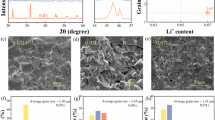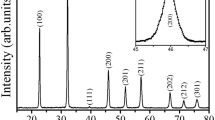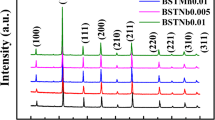Abstract
Lead‐free ferroelectric electrocaloric ceramics that could convert electrical energy into heat are the promising candidate for environment‐friendly cooling devices. For refrigeration devices, a large temperature change (ΔT) and good temperature stability are required, which are highly related to the phase structure and the applied electric field. In this work, a diffused ferroelectric–paraelectric (FP) phase transition is formed in (K, Na)NbO3 (KNN) by using appropriate composition engineering. The relaxor ferroelectrics in this work present both a large ΔT of 1.24 K and a high ΔT/ΔE of 0.19 K mm/kV. In addition, a wide temperature span exceeds 55 °C at the high electrocaloric effect (ECE) criterion (ΔT ≥ 0.5 K) could also be observed. This work not only opens a new strategy for obtaining high‐performance ceramics for refrigeration devices but also extends the application area of the KNN‐based lead‐free ferroelectrics from sensors, actuators and energy harvesting to solid‐state cooling applications.









Similar content being viewed by others
References
G. Zhang, Z. Chen, B. Fan, J Liu, M. Chen, M. Shen, P. Liu, Y. Zeng, S. Jiang, and Q. Wang: Large enhancement of the electrocaloric effect in PLZT ceramics prepared by hot‐pressing. APL Mater. 4, 064103 (2016).
S. Fähler and V.K. Pecharsky: Caloric effects in ferroic materials. MRS Bull. 43, 264 (2018).
J. J. Wang, D. Fortino, B. Wang, X. Zhao, and L.Q. Chen: Extraordinarily large electrocaloric strength of metal‐free perovskites. Adv. Mater. 32, 1906224 (2020).
X. Moya, S.K. Narayan, and N.D. Mathur: Caloric materials near ferroic phase transitions. Nat. Mater. 13, 439 (2014).
A. Mischenko, Q. Zhang, J.F. Scott, R.W. Whatmore, and N.D. Mathur: Giant electrocaloric effect in thin‐film PbZr0.95Ti0.05O3. Science 311, 1270 (2006).
Y. Yu, F. Gao, F. Weyland, H. Du, L. Jin, L. Hou, Z. Yang, N. Novak, and S. Qu: Significantly enhanced room temperature electrocaloric response with superior thermal stability in sodium niobate‐based bulk ceramics. J. Mater. Chem. A 7, 11665 (2019).
J. Koruza, B. Roži, G. Cordoyiannis, B. Malič, and Z. Kutnjak: Large electrocaloric effect in lead‐free K0.5Na0.5NbO3‐SrTiO3 ceramics. Appl. Phys. Lett. 106, 202905 (2015).
C. Zhao, Y. Huang, and J. Wu: Multifunctional barium titanate ceramics via chemical modification tuning phase structure. InfoMat (2020). doi:10.1002/inf2.12147.
R. Zuo and J. Fu: Rhombohedral‐tetragonal phase coexistence and piezoelectric properties of (NaK)(NbSb)O3‐LiTaO3‐BaZrO3 lead‐free ceramics. J. Am. Ceram. Soc. 94, 1467 (2011).
H. Tao, H. Wu, Y. Liu, Y. Zhang, J. Wu, F. Li, X. Lyu, C. Zhao, D. Xiao, J. Zhu, and S.J. Pennycook: Ultrahigh performance in lead‐free piezoceramics utilizing a relaxor slush polar state with multiphase coexistence. J. Am. Chem. Soc. 141, 13987 (2019).
L. Zhao, X. Ke, Z. Zhou, X. Liao, J. Li, Y. Wang, M. Wu, T. Li, Y. Bai, and X. Ren: Large electrocaloric effect over a wide temperature range in BaTiO3‐modified lead‐free ceramics. J. Mater. Chem. C 7, 1353 (2019).
X. Wang, J. Wu, B. Dkhil, B. Xu, X. Wang, G. Dong, G. Yang, and X. Lou: Enhanced electrocaloric effect near polymorphic phase boundary in lead‐free potassium sodium niobate ceramics. Appl. Phys. Lett. 110, 063904 (2017).
R. Kumar and S. Singh: Enhanced electrocaloric response and high energy‐storage properties in lead‐free (1‐x)(K0.5Na0.5)NbO3‐xSrZrO3 nanocrystalline ceramics. J. Alloys Compd. 764, 289 (2018).
J. Yang, Y. Zhao, X. Lou, J. Wu, and X. Hao: Synergistically optimizing electrocaloric effects and temperature span in KNN‐based ceramics utilizing a relaxor multiphase boundary. J. Mater. Chem. C 8, 4030 (2020).
J. Wu, D. Xiao, and J. Zhu: Potassium‐sodium niobate lead‐free piezoelectric materials: Past, present, and future of phase boundaries. Chem. Rev. 115, 2559 (2015).
Y. Li, Y. Zhen, W. Wang, Z. Fang, Z. Jia, J. Zhang, H. Zhong, J. Wu, Y. Yan, Q. Xue, and F. Zhu: Enhanced energy storage density and discharge efficiency in potassium sodium niobite‐based ceramics prepared using a new scheme. J. Eur. Ceram. Soc. 40, 2357 (2020).
X. Lv and J. Wu: Effects of a phase engineering strategy on the strain properties in KNN‐based ceramics. J. Mater. Chem. C 7, 2037 (2019).
B. Wu, C. Zhao, Y. Huang, J. Yin, W. Wu, and J. Wu: Superior electrostrictive effect in relaxor potassium sodium niobate based ferroelectrics. ACS Appl. Mater. Interfaces 12, 25050 (2020).
X. Li, S.G. Lu, X.Z. Chen, H. Gu, X. Qian, and Q.M. Zhang: Pyroelectric and electrocaloric materials. J. Mater. Chem. C 1, 23 (2013).
G. Vats, A. Kumar, N. Ortega, C.R. Bowen, and R.S. Katiyar: Giant pyroelectric energy harvesting and a negative electrocaloric effect in multilayered nanostructures. Energ. Environ. Sci. 9, 1335 (2016).
M. Guo, M. Wu, W. Gao, B. Sun, and X. Lou: Giant negative electrocaloric effect in antiferroelectric PbZrO3 thin films in an ultra‐low temperature range. J. Mater. Chem. C 7, 617 (2019).
M. Valant: Electrocaloric materials for future solid‐state refrigeration technologies. Prog. Mater. Sci. 57, 980 (2012).
C. Zhao, J. Yang, Y. Huang, X. Hao, and J. Wu: Broad‐temperature‐span and large electrocaloric effect in lead‐free ceramics utilizing successive and metastable phase transitions. J. Mater. Chem. A 7, 25526 (2019).
E. Li, H. Kakemoto, S. Wada, and T. Tsurumi: Influence of CuO on the structure and piezoelectric properties of the alkaline niobate‐based lead‐free ceramics. J. Am. Ceram. Soc. 90, 1787 (2007).
J.B. Lim, S. Zhang, J.H. Jeon, and T.R. Shrout: (K,Na)NbO3‐based ceramics for piezoelectric “hard” lead‐free materials. J. Am. Ceram. Soc. 93, 1218 (2010).
H.Y. Park, J.Y. Choi, M.K. Choi, K.H. Cho, S. Nahm, H.G. Lee, and H.W. Kang: Effect of CuO on the sintering temperature and piezoelectric properties of (Na0.5K0.5)NbO3 lead‐free piezoelectric ceramics. J. Am. Ceram. Soc. 91, 2374 (2008).
Y. Chang, S.F. Poterala, Z. Yang, S.T. McKinstry, and G.L. Messing: Microstructure development and piezoelectric properties of highly textured CuO‐doped KNN by templated grain growth. J. Mater. Res. 25, 687 (2011).
R.D. Shannon: Revised effective ionic radii and systematic studies of interatomic distances in halides and chalcogenides. Acta Cryst. A32, 751 (1976).
X. Lv, J. Zhu, D. Xiao, X. Zhang, and J. Wu: Emerging new phase boundary in potassium sodium‐niobate based ceramics. Chem. Soc. Rev. 49, 671 (2020).
Y. Huang, C. Zhao, J. Yin, X. Lv, J. Ma, and J. Wu: Giant electrostrictive effect in lead‐free barium titanate‐based ceramics via A‐site ion‐pairs engineering. J. Mater. Chem. A 7, 17366 (2019).
J. Xing, S. Xie, B. Wu, Z. Tan, L. Jiang, L. Xie, Y. Cheng, J. Wu, D. Xiao, and J. Zhu: Influence of different lanthanide ions on the structure and properties of potassium sodium niobate based ceramics. Scr. Mater. 177, 186 (2020).
X. Ren, Z. Peng, B. Chen, Q. Shi, X. Qiao, D. Wu, G. Li, L. Jin, Z. Yang, and X. Chao: A compromise between piezoelectricity and transparency in KNN‐based ceramics: The dual functions of Li2O addition. J. Eur. Ceram. Soc. 40, 2331 (2020).
F. Huang, H. Tian, X. Meng, P. Tan, X. Cao, Y. Bai, C. Hu, and Z. Zhou: Large room temperature electrocaloric effect in KTa1‐xNbxO3 single crystal. Phys. Status Solidi RRL 13, 1800515 (2019).
J. Li, Y. Bai, S. Qin, J. Fu, R. Zuo, and L. Qiao: Direct and indirect characterization of electrocaloric effect in (Na,K)NbO3 based lead‐free ceramics. Appl. Phys. Lett. 109, 162902 (2016).
L. Zhang, C. Zhao, T. Zheng, and J. Wu: Large electrocaloric effect in (Bi0.5Na0.5)TiO3‐based relaxor ferroelectrics. ACS Appl. Mater. Interfaces 12, 33934 (2020).
F.L. Goupil, A.K. Axelsson, L.J. Dunne, M. Valant, G. Manos, T. Lukasiewicz, J. Dec, A. Berenov, and N.M. Alford: Anisotropy of the electrocaloric effect in lead‐free relaxor ferroelectrics. Adv. Energ. Mater. 4, 1301688 (2014).
M. Sanlialp, V.V. Shvartsman, M. Acosta, B. Dkhil, and D.C. Lupascu: Strong electrocaloric effect in lead‐free 0.65Ba(Zr0.2Ti0.8)O3‐0.35(Ba0.7Ca0.3)TiO3 ceramics obtained by direct measurements. Appl. Phys. Lett. 106, 062901 (2015).
R. Kumar, A. Kumar, and S. Singh: Large electrocaloric response and energy storage study in environmentally friendly (1‐x)K0.5Na0.5NbO3‐xLaNbO3 nanocrystalline ceramics. Sustain. Energ. Fuels 2, 2698 (2018).
R. Kumar, A. Kumar, and S. Singh: Coexistence of large negative and positive electrocaloric effects and energy storage performance in LiNbO3 doped K0.5Na0.5NbO3 nanocrystalline ceramics. ACS App. Electron. Mater. 1, 454 (2019).
S. Kumar and S. Singh: Study of electrocaloric effect in lead‐free 0.9K0.5Na0.5NbO3‐0.1CaZrO3 solid solution ceramics. J. Mater. Sci.: Mater. Electron. 30, 12924 (2019).
J. Yang and X. Hao: Electrocaloric effect and pyroelectric performance in (K,Na)NbO3‐based lead‐free ceramics. J. Am. Ceram. Soc. 102, 6817 (2019).
S.M. Pilgrim, A.E. Sutherland, and S.R. Winzer: Diffuseness as a useful parameter for relaxor ceramics. J. Am. Ceram. Soc. 73, 3122 (1990).
Y. Huang, C. Zhao, B. Wu, and J. Wu: Multifunctional BaTiO3‐based relaxor ferroelectrics toward excellent energy storage performance and electrostrictive strain benefiting from crossover region. ACS Appl. Mater. Interfaces 12, 23885 (2020).
Acknowledgments
The authors gratefully acknowledge the supports of the National Science Foundation of China (NSFC No. 51722208).
Author information
Authors and Affiliations
Corresponding author
Rights and permissions
About this article
Cite this article
Zhang, N., Zheng, T., Zhao, C. et al. Enhanced electrocaloric effect in compositional driven potassium sodium niobate‐based relaxor ferroelectrics. Journal of Materials Research 36, 1142–1152 (2021). https://doi.org/10.1557/s43578-020-00081-6
Received:
Accepted:
Published:
Issue Date:
DOI: https://doi.org/10.1557/s43578-020-00081-6




